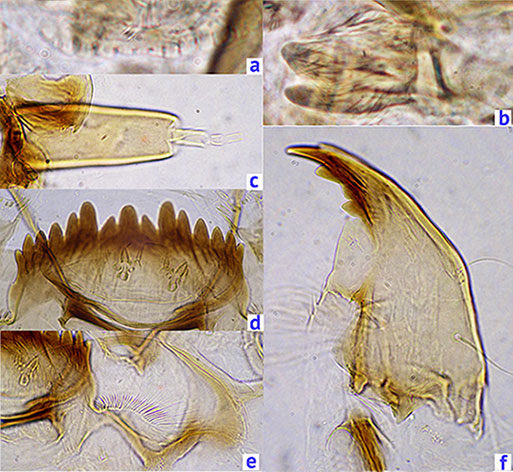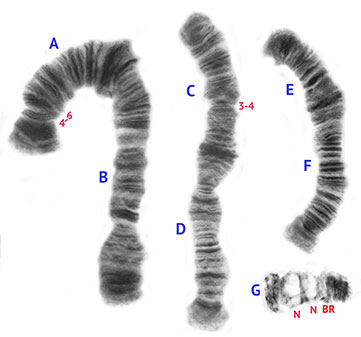Species nr. sp. u. C. nr. species u.
Known from a single larva collected by Patrick. L. Hudson (it is possible that there is another specimen in the collection of J.E. Sublette, in the Museum of the University of Minnesota).
Fourth instar larva: Larval type not known, as only the head capsule was mounted on the slide. Ventral head length 316 µm.
.
Mentum (Fig. d, below) of type I (4th laterals only slightly reduced), c2 teeth partly separated, either type IIA or a worn IV.
Ventromental plates (Fig. e, below) separated by about 49% of mentum width, about 3.3 times longer than deep and abt 1.3 times the mentum width, with 43-45 striae; VMR perhaps 1.9.
Pecten epipharyngis (Fig. a, below) with 14 teeth, very worn, possibly type B.
Premandible (Fig. b, below) broader than usual even if relatively worn, with inner tooth about 4 times wider, between types D and E.
Antenna (Fig. c, below) with A1 segment about 2.9 times longer than wide, RO about halfway up from base; LR 2.30; antennal proportions (micron) 125 : 23 : 8 : 11 : 7.
Distance between the antennal bases less than that between the S4 setae.
Mandible (Fig. f, below) with third inner tooth separated and darkened (type IIIC); 12 furrows on inner surface near base, 9-10 taeniae in Pecten mandibularis; MTR about 0.33.

Cytology: Four relatively short polytene chromosomes with the thummi arm combination AB, CD, EF, G.
Centromeres moderately heterochromatic.
 Arm A1: 1 - 2c, 10 - 12, 3, 8 - 9, 2k-d, 4 - 6c, 7 - 6d, 13 - 19
Arm A1: 1 - 2c, 10 - 12, 3, 8 - 9, 2k-d, 4 - 6c, 7 - 6d, 13 - 19
Arm B1: Puff (group 7) not developed. Distal end (about bands 1 - 9) may be as in piger.
Arm C1: Groups 3-4 about middle of arm (may be groups 1 - 9, from telomere). Possibly as aberratus.
Arm D1: Groups 15 - 16 about 1/3 from centromere. Perhaps 16-24 to centromere, but possible small inversion at distal end.
Arm E1: 1 - 3e, 5 - 10b, 4 - 3f, 10c - 13 i.e. as aberratus, cucini, etc.
Arm F1: 1, 5 - 2, 6 - 10, 17 - 11, 18 - 23. i.e. inv2-5 from aberratus, sororius, etc.
Arm G1: Paired at the terminal nucleolus, followed by a constriction and with a large BR relatively close.
[ Go to C. species u | Go to Index | Go to References ]
|

